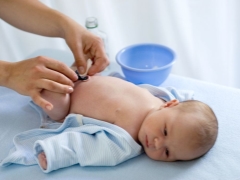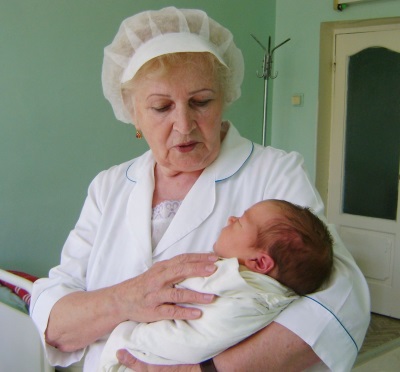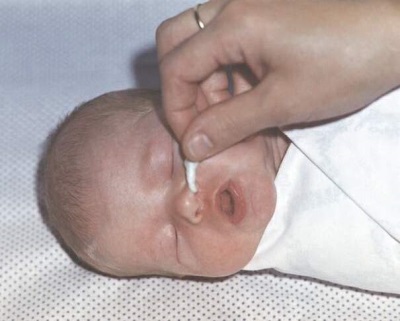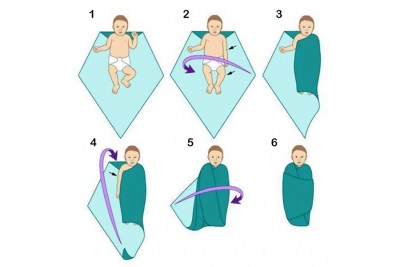Caring for a newborn baby
While waiting for the baby, each woman studies information about the first days in the maternity hospital. Although the process of childbirth and the entire stay in the hospital maternity hospital is frightening, nevertheless, during this period the young mother will be under the supervision of the medical staff. Difficulties may arise after discharge, so how to care for a newborn baby should be known in advance.
Who will teach to care?
Questions to care for newborn tots are discussed in courses for expectant mothers, so if a pregnant woman attends such classes, she will be theoretically prepared for the upcoming care of the baby. Also, information about the care of the baby, the expectant mother can get from special magazines and books.
Teach the practice of caring for the baby and explain its basic principles should also be in the hospital. Pediatric nurse and pediatrician will tell and show the woman in labor all the actions that she will need to care for the crumbs. The first toilet of the baby is held by the nurse, and then, having received step-by-step instructions, the young mother, under the supervision of a nurse, performs basic hygienic procedures on her own.
In addition, immediately after discharge, the mother with the newborn baby should be visited by the district pediatrician along with the patronage nurse. They can ask any questions about the care of the baby and the health of the crumbs. In advance
Care in the hospital
Immediately after birth, the baby is tied up with an umbilical cord with special sterile clips attached to it. Wrapping the baby in a diaper, the crumb is transferred to a heated table for the first hygienic procedures. The midwife takes a sterile cloth, dips it into sterile oil, and then partially wipes the newborn off from the original lubricant. Next, the toddler is weighed and measured.
When a mother with a baby is transferred to the ward, they are visited by a nurse or pediatrician, showing the woman how to handle the umbilical cord, as well as how to wash the baby under the tap. Every morning the newborn in the hospital spend the morning toilet, including washing the face and eyes, as well as the processing of the rest of the umbilical cord. The nose and ears are washed when necessary.
Daily morning care
After discharge, every morning a newborn baby should begin with a wash. To do this, wadded disk is dipped into boiled warm water and wrung out, after which a wet disk is wiped with:
- Little baby face.
- Eyes crumbs. Movement should be from the outside corners towards the spout. For each eye, use a separate cotton pad.
- Baby ears. It is necessary to wipe the skin behind the ears and curls of the shell.
- Neck baby.
In addition, the mother should daily examine the entire skin of the infant and detect redness of the folds in time. When diaper rash appears, the air baths and special cosmetics are shown to the baby.
The rules of the morning toilet are described in detail in the video of the channel "Caring Mom" on Youtube.
Navel treatment
The navel of a newborn usually heals during the first two weeks of the baby’s life. Treatment of the navel should be carried out until complete healing.
After bathing, the wound, which remains after the fall of the umbilical cord residue, should be processed as follows:
- To process you need to prepare antiseptic, cotton swabs and peroxide solution.
- Mom must wash his hands.
- Cotton swab moistened with peroxide, and then treated the wound so that it was cleared of detachable.
- Remnants of peroxide clean with a dry stick.
- Moisten another cotton swab in an antiseptic and treat navels. Zelenka is most commonly used, but it can also be chlorophilipt, iodine solution or calendula tincture.
- Try not to touch the skin when processing.
Laundry and diapers
After each chair, the newborn baby should be undermined. If there is no stool, washing is performed every 2-3 hours. This procedure is performed under running water, as a urinary tract infection may occur due to washing in the bath or pelvis. Do not forget to make sure that the water that flows from the tap has a comfortable temperature for the infant. While washing away a newborn girl, you should move from front to back.
On how to bathe a newborn baby, see the following video.
When the rinsing is complete, place the baby on a changing table or sofa, then blot water from the skin using a clean diaper. Next, treat the folds with a cotton ball smeared with vegetable oil. Also for the treatment of folds, you can use a baby cream.
Diapers for a newborn can be both disposable and reusable. The baby should not be in a disposable diaper for more than 4 hours. Put the diaper on the newborn baby so that the navel remains open. This will promote faster healing of the wound. During the day, the baby should spend some time without a diaper.
On the rules of daily care for the newborn, see the following video.
Weekly care
This care includes procedures that are not performed every day, but are performed as needed.
Nose Care
Newborn babies have tiny nasal passages, so even with a slight clogging the breath of the baby becomes difficult. To clean the baby's nose use flagella that twist out of cotton. They are moistened in vegetable or petroleum jelly, after which a rotational movement is introduced a maximum of 1 cm inside the spout. You can also soak the cotton flagellum with boiled water or breast milk.
A separate flagellum is used for each nasal passage. Never use cotton swabs to clean the nose of a newborn.
How to do it right, see the video.
Ear care
Earwax is normal and to remove its excess, you should use special sticks with cotton tips. Since the ears of newborns are very small, such sticks should be with a limiter so that the stick does not penetrate too deeply and cause irritation of the eardrum.
Instead of a wand, you can use a cotton flagella, but you cannot insert it into the ear canal. Also, do not rub your ears much. In order to remove sulfur more easily, a cotton wool can be slightly moistened with boiled water, however, at the same time, water should not drip from the cotton wool.
Nail care
For many newborns, the length of the nails immediately after birth is such that it is necessary to trim them back in the maternity hospital. Baby marigolds grow very quickly, but they are very thin, so they often bend or break.
Weekly, nails are cut with special tweezers or nail scissors, trying not to cut off too much so as not to touch the skin on the fingers. On the handles of the baby, the edges of the nail should be slightly rounded off, and on the legs, the nail should be cut straight. It is convenient for a newborn to cut nails during sleep, then the procedure will not disturb the baby.
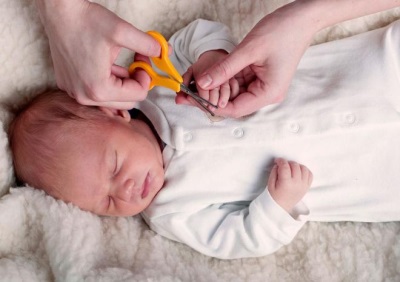
For information on how to handle newborn babies, see the following video by Olga Vasilyevna Parshikova.
Bathing
For the first time, it is allowed to bathe the newborn on the same day, when the baby and his mother were discharged from the hospital.
The peculiarities of the procedure should be clarified by the referral nurse:
- It is most convenient to bathe the baby before feeding, which will be the last.
- The newborn should be bathed in a separate bath until the navel is completely healed.
- The average duration of the procedure is from three to seven minutes.
- Until the moment when the umbilical wound heals completely, bathing crumbs should be held in boiled water.
- The optimal parameters of air temperature in the room where they spend swimming, called + 24 + 26 ° C.
- While swimming in the room should not be drafts.
- Before the procedure, the bath should be washed with soap and scalded with boiling water.
- Before you fill the bath with water, prepare everything you need while bathing. You need to put boiled water, baby soap, a soft biken mitten, a thermometer for water, a douche for bathing, a towel, oil or a cream after bathing, clean clothes next to the bath.
- The hands of a man bathing a baby should be washed with soap and with cropped nails. Rings and watches before the procedure should be removed.
- At the bottom of the bath it is advised to put a diaper, and then pour water, the temperature of which should be about + 37 ° C.
- Water is poured to the level of 10-15 cm so that after immersion in it the head and top of the baby’s chest remain above the water.
- It is necessary to lower the baby slowly, starting from the feet. The head is held on the elbow, and the second hand is washed with a crumb. In this case, the baby should not be rubbed so as not to damage the delicate skin.
- After washing the soap off, the baby is turned back up to pour boiling clean water from a jug, the temperature of which should be one degree lower than the water when bathing.
- Wrapping the baby in a towel (the skin is not recommended for rubbing), folds are treated with oil or cream, then the baby is dressed in clean clothes, allowed to rest and feed a little.
- After the navel has healed, you can begin bathing your baby in a normal bath using tap water. Bathing time begins to increase to 30-40 minutes.
Every day, the baby is washed with soap and buttocks and genitals. The whole body is recommended to wash with soap no more than once or twice a week.

Walking
The first walk with a newborn in the summer can be carried out on the first day after discharge. In autumn, winter and spring, the child is taken out two or three days after discharge and only at temperatures above -5 ° C.
The duration of the first walks should be 10-15 minutes, and by the end of the first month of life, the total stay of the baby in the fresh air should be at least 1.5 hours. If it is cold outside, it is recommended to walk for 20-30 minutes several times a day.
clothing
Many mothers immediately put a newborn in slips, bodysuits, blouses and sliders, but many experienced moms advise you to learn how to swaddle a toddler. Thanks to swaddling, the baby feels more comfortable, because in his mother's belly he was cramped and after giving birth the baby in the first days had not yet adapted to the huge space around. Swaddling can be whole body or with free handles. The diaper is wrapped loosely so that the crumb could freely move under her legs and arms.
Clothes for a newborn baby need to pick up soft and not cramped. If the air temperature in the room is + 20 ° + 22 ° C, the cap is not needed. In the selection of clothing take into account the weather and time of year, as well as the health of the toddler. It is important to choose such clothes so that the baby does not freeze in it, but also so that the crumbs do not get too hot. The best advice for dressing a baby would be to dress a baby in the same way that a mother is dressed, plus add one layer of clothing.
Microclimate in the house
Maintaining a certain temperature and humidity in your home is very important for caring for newborn. In winter, the temperature in the room should be no higher than + 22 ° С, and in summer - no higher than + 24 ° С. The best temperature for a night sleep of newborns is called + 19 ° С. Optimum humidity parameters in the room - from 50 to 70%. Every day, in the room where the newborn resides, wet cleaning is carried out.
See the next lecture “Care for the Newborn”, which is conducted by Kovbasko Ekaterina Ivanovna - a pediatrician of the highest category.
